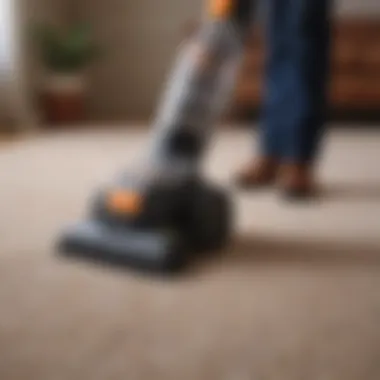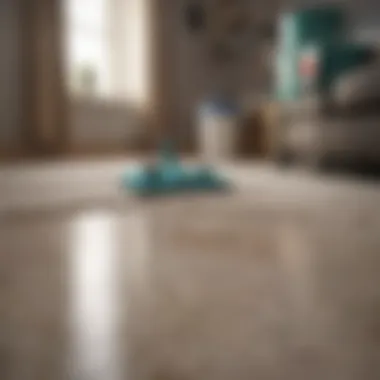A Comprehensive Guide to Cleaning Your Carpet Cleaner


Intro
Cleaning is an essential part of maintaining any home, and when it comes to carpets, a carpet cleaner is a valuable tool. However, what many do not realize is that these machines require their own maintenance to function optimally. In this guide, we delve into the specifics of cleaning your carpet cleaner. This process not only extends the life of the machine but also ensures effective cleaning of your carpets. We will cover various components, offer cleaning techniques, and outline necessary precautions. Through this, both homeowners and cleaning enthusiasts will find practical insights to improve the efficiency of their carpet cleaning endeavors.
Understanding Your Carpet Cleaner
Understanding how your carpet cleaner operates is crucial for maintaining its effectiveness. A carpet cleaner is not merely an appliance; it is a vital tool that assists in preserving your home's cleanliness and extending the life of your carpets. Without proper knowledge, you may overlook key maintenance measures. This understanding sets the foundation for optimal performance, ensuring that you can achieve the best results while cleaning.
Types of Carpet Cleaners
There are various types of carpet cleaners available on the market, each specially designed to cater to distinct needs. The most common types include upright, portable, and steam cleaners. Upright carpet cleaners generally offer robust suction and are suitable for large areas, while portable models provide convenience for spot cleaning and are easy to maneuver. Steam cleaners utilize hot water vapor to dissolve dirt effectively and sanitize surfaces without the use of harsh chemicals. Understanding these differences will help you select the right cleaner for your specific requirements and inform your cleaning techniques.
Key Components to Clean
Regularly cleaning the essential components of your carpet cleaner will directly impact its longevity and performance. The primary elements that require attention are:
- Water Tank: This holds the cleaning solution and water. A dirty water tank can lead to contamination of your cleaning solution.
- Brush Roll: The bristles on the brush roll play a crucial role in agitating the carpet fibers to lift dirt and stains. Hair and debris can get caught here, preventing effective cleaning.
- Filters: These ensure that dirt and debris do not recirculate into the carpet. Filters should be cleaned regularly to maintain optimal airflow.
- Hoses and Nozzles: Blockages in hoses and nozzles can reduce the suction power of your carpet cleaner, making it less effective.
Maintaining cleanliness in these key components not only ensures your cleaner works well but also improves your carpet's overall appearance.
"Proper maintenance of your carpet cleaner will enhance its cleaning efficiency, ultimately protecting your carpet investment."
By comprehending your carpet cleaner’s function and the details of its components, you can effectively sustain its utility and ensure the best cleaning outcomes for your carpets.
Why Cleaning Your Carpet Cleaner is Necessary
Cleaning your carpet cleaner may seem tedious, but its importance cannot be overstated. Regular maintenance keeps your machine in top condition. Without consistent cleaning, buildup can interfere with performance. This ultimately leads to less effective cleaning of your carpets.
Effect on Cleaning Efficiency
The performance of a carpet cleaner directly correlates with its cleanliness. Dust, dirt, and residues from cleaning solutions can accumulate over time. This buildup blocks nozzles and filters, reducing suction power. The result is a machine that does not extract dirt effectively. If your cleaner is not working as intended, your carpets will not get the deep clean they require.
To ensure cleanliness, regular inspections and cleaning are vital. Pay attention to areas such as the brush roll and filters. If they appear dirty, a thorough cleaning will restore suction power and performance. A clean carpet cleaner improves results. It reduces the need for multiple passes to achieve the desired cleanliness level.
Impact on Carpet Lifespan


A properly cleaned carpet cleaner can significantly affect the longevity of your carpets. When dirt and grime are effectively removed, fibers stay intact. When dirt is left behind, it can cause fibers to break down over time. This leads to fraying and discoloration. Such damage often necessitates costly repairs or replacements.
Furthermore, the use of dirty cleaning machines can introduce pollutants back into the carpet. This diminishes air quality and can negatively impact health. Regularly maintaining your carpet cleaner not only secures its performance but also protects your investments in flooring. Maintaining a clean machine translates directly into a longer lifespan for your carpets.
"Regular cleaning of your carpet cleaner ensures optimal efficiency and protects your flooring investments."
By prioritizing these key aspects, you ensure your cleaning tool performs effectively. Remember, the necessity of keeping your carpet cleaner spotless cannot be ignored.
Gather Essential Cleaning Supplies
Gathering the right cleaning supplies is a crucial step in the process of maintaining your carpet cleaner. Using the appropriate agents and tools not only enhances the cleaning process but also ensures that the machine remains in optimal working condition. Here, we will delve into the specific elements that are necessary for effective carpet cleaner maintenance, focusing on the benefits and considerations involved in selecting the right supplies.
Recommended Cleaning Agents
The selection of cleaning agents is central to the maintenance of your carpet cleaner. It is important to choose products that are specially formulated for use with carpet cleaning machines.
Some effective agents include:
- Carpet Shampoo: A dedicated carpet shampoo helps to dissolve dirt and grime effectively. Look for a product that is biodegradable to ensure it is eco-friendly.
- Enzymatic Cleaners: These products utilize naturally occurring enzymes to break down organic stains. They are particularly effective on food, pet stains, and other tough marks.
- Soap-based Cleaners: While effective, ensure that they can be rinsed out well, as soapy residues can attract dirt in future cleanings.
When considering which agent to utilize, be attentive to the manufacturer's guidelines. Using non-recommended agents can damage the internal parts of your cleaner or void warranties, leading to unnecessary costs for repairs or replacements.
Tools and Accessories
In addition to cleaning agents, having the right tools and accessories is important for an efficient cleaning process. These items can significantly simplify various tasks involved in maintaining your carpet cleaner.
Essential tools include:
- Soft Brushes: For scrubbing delicate parts without causing damage. Soft-bristled brushes are great for cleaning inaccessible areas.
- Microfiber Cloths: Utilized for wiping down surfaces. They are effective in capturing dust and grime without leaving lint behind.
- Screwdrivers: Necessary for any disassembly required during cleaning. A simple toolkit with different sizes will make it easier for you to access various components of your carpet cleaner.
- Vacuum attachments: If your unit allows it, use attachments to remove debris and dirt before steam cleaning. This ensures that you will not spread dirt around while working.
Step-by-Step Cleaning Instructions
Cleaning your carpet cleaner may seem daunting, but following a structured approach can greatly simplify the task. This section is vital for ensuring the longevity and efficiency of your device. Regular cleaning prevents build-up of residue, which can lead to poor performance and unwanted odors. The process is straightforward and requires just a few essential tools and cleaning agents. By implementing a step-by-step method, you can ensure that every component is thoroughly cleaned, contributing to the overall effectiveness of your carpet cleaner.
Disassembling Your Carpet Cleaner
Before cleaning, it is important to properly disassemble your carpet cleaner. Each model may differ, but most cleaning devices have parts designed for easy removal. Begin by unplugging the machine and removing the water tank. Make sure to check for any screws or clips that may hold components in place. Be gentle during this process; you want to avoid damaging any parts. Refer to your user manual for specific instructions, if needed. This initial step sets the stage for an effective cleaning session, allowing you to access areas that may have accumulated dirt and grime.


Cleaning the Water Tank
The water tank is one of the most critical components to keep clean. Residue from cleaning solutions can build up, causing bacteria and mold to form. Rinse the tank with warm water first. Then, use a mild detergent to scrub the inside with a soft brush. Pay attention to any corners and crevices. After scrubbing, rinse thoroughly to ensure all soap is removed. Let the tank dry completely before you refill it with clean water. A clean water tank will improve the quality of the cleaning solution used during subsequent cleanings.
Cleaning the Brush Roll
The brush roll plays a major role in carpet cleaning. It agitates dirt and debris from the carpet fibers. Over time, hair and fibers can get tangled around the bristles, reducing its effectiveness. Start by removing the brush roll from the carpet cleaner. Use scissors to carefully cut away any hair or fibers wrapped around the brush. Next, wash the brush with warm soapy water and a soft cloth. Ensure it is completely dry before reinstallation. A well-maintained brush roll boosts cleaning performance.
Cleaning the Filters
Filters are crucial for preventing clogs and improving suction power. Depending on the model, your carpet cleaner may have multiple filters that need attention. Locate the filters and remove them carefully. Most filters can be rinsed under warm water. Use a soft brush to remove any embedded dirt. Some filters may be washable while others may need replacement. Always check the manufacturer’s guidelines regarding filter cleaning for your specific model. Keeping filters clean ensures that your machine operates at peak efficiency.
Reassembling the Carpet Cleaner
Once all parts are cleaned and dried, it's time to reassemble your carpet cleaner. Start by reinserting the filters followed by the brush roll. Make sure all components fit snugly. Finally, attach the water tank back in place. Before using the machine, do a quick visual inspection to ensure everything is securely assembled. Taking this careful approach during reassembly will prevent any potential damage or operational issues.
Remember, proper maintenance significantly impacts the performance of your carpet cleaner. Regular cleaning keeps your equipment ready for action whenever you need it.
Best Practices for Maintenance
Maintaining your carpet cleaner goes beyond occasional cleaning; it involves implement optimistic strategies that enhance both its performance and lifespan. Regular upkeep helps prevent complications such as clogs or mechanical failure, ultimately contributing to effective cleaning of your carpets. By adopting best practices, you can maintain the machine's efficiency and reliability over time conducive to maintaining a healthy living space.
Regular Cleaning Schedule
Establishing a regular cleaning schedule is perhaps the most crucial aspect of maintenance. A consistent timeframe allows you to keep your carpet cleaner operating optimally. Here are several key points to consider:
- Frequency: Ideally, you should clean your carpet cleaner after every major use or at least monthly for occasional users. This helps remove dirt, mildew, and odors that can accumulate.
- Checklist: Create a checklist of tasks to carry out during each cleaning session. This can include:
- Set Reminders: Use calendar reminders or apps to ensure no step is neglected over time. Consistency can result in much better carpet cleaning outcomes.
- Disassembling and cleaning the water tank
- Inspecting and cleaning the brush roll
- Washing the filters
- Wiping down exterior surfaces
"A cleaning schedule can greatly improve your carpet cleaner's performance, ultimately saving you time and effort in the long run."
Storage Guidelines
Proper storage is equally important to ensure that your carpet cleaner remains in good condition. How and where you store your cleaner can directly affect its longevity. Here’s what to keep in mind:
- Location: Store your machine in a cool, dry place. Avoid areas with high humidity as moisture can promote mold growth in the components.
- Positioning: Standing your carpet cleaner upright prevents potential leaks from the tank. Ensure it is stable to avoid damage.
- Accessories: Keep all cleaning accessories together. Organize hoses, brushes, and cleaning agents in a dedicated container. This makes access easier and reduces wear on the cleaner attached elements.
- Avoid Overloading: When storing, ensure the machine is not overloaded with additional tools that might damage it. Accessories should be stored separately or within designated compartments designed for that purpose.


By implementing these best practices for maintenance, you can ensure that your carpet cleaner not only performs well but also lasts longer. Investing time in maintenance pays off with consistently clean carpets, enhancing the comfort and aesthetics of your living environment.
Troubleshooting Common Issues
Cleaning your carpet cleaner is an essential aspect of maintaining its overall performance and prolonging its lifespan. However, even with regular maintenance, problems can arise that may affect the machine's efficiency. Understanding how to troubleshoot common issues can save you time, money, and frustration. This section will cover two critical areas: identifying performance issues and resolving odor problems.
Identifying Performance Issues
When your carpet cleaner shows signs of decreased efficiency, it can be frustrating. Common performance issues can include reduced suction power, uneven cleaning, or failure to spray water or cleaning solution. Here are some steps to assist in identifying these issues:
- Check for Blockages: Start by examining the hose, brush roll, and water tank for any debris or clogs. A blockage can severely hinder suction and overall effectiveness.
- Inspect the Filters: Dirty filters can cause airflow restrictions. Always clean or replace them as needed, following the manufacturer's instructions.
- Examine the Brush Roll: If the brush roll is not rotating correctly, it can lead to poor carpet cleaning results. Look for hair, lint, or other substances that may be wrapped around the brush.
- Evaluate Water Levels: Insufficient water can affect cleaning performance. Ensure your water tank is full and properly seated.
These steps can help you diagnose the issue before seeking professional assistance or considering a replacement. Addressing performance issues quickly can restore your carpet cleaner's efficiency.
Resolving Odor Problems
Persistent odors emanating from your carpet cleaner may signal the presence of mold, mildew, or residual cleaning solutions. Here are strategies to effectively resolve these concerns:
- Clean the Water Tank: After each use, empty and rinse the water tank to prevent buildup. You can use a mixture of vinegar and baking soda to eliminate any lingering odors.
- Regularly Wash the Brush Roll: The brush roll can accumulate hair and other debris. Clean it thoroughly to prevent smells that may develop from trapped dirt.
- Dry Components Properly: Always allow your carpet cleaner components to dry completely before reassembling them. This step is vital to prevent moisture accumulation that can lead to mold growth.
- Use Odor Neutralizers: Consider using products specifically designed to neutralize odors caused by carpet cleaners. Many options are available, but always check that they are compatible with your device.
"Preventing odors is an essential part of carpet cleaner care. Regular maintenance and cleaning routines can significantly reduce the chances of foul smells."
By understanding common issues and how to troubleshoot them, you can maintain your carpet cleaner effectively. This knowledge will lead to better performance and a more pleasant cleaning experience.
Ending
Cleaning and maintaining your carpet cleaner is an integral part of ensuring its optimal function and longevity. As discussed in this article, regular upkeep not only enhances the effectiveness of your cleaner but also extends the lifespan of both the machine and the carpets in your home. Keeping the device in good condition minimizes the risk of malfunctions and inefficiencies that can compromise your cleaning results.
Summary of Key Points
In summary, here are the essential takeaways from this guide:
- Understanding Your Carpet Cleaner: Recognizing the types of machines and their components is crucial for effective cleaning.
- Necessity of Cleaning: Regular maintenance directly affects cleaning efficiency and the lifespan of your carpets.
- Supplies and Tools: Having the right cleaning agents and tools simplifies the cleaning process.
- Systematic Cleaning Steps: Following a step-by-step approach ensures thorough cleaning of all components.
- Routine Maintenance Practices: Establishing a regular cleaning schedule and following proper storage guidelines will help in preserving the integrity of your carpet cleaner.
- Troubleshooting: Being able to identify and resolve common issues helps maintain the machine's performance.
Encouragement for Regular Maintenance
It is critical to adopt a habit of regular maintenance for your carpet cleaner. Consistent cleaning practices will make the task less daunting over time, allowing you to consistently achieve the best results.
Regular maintenance not only helps you avoid costly repairs but also ensures that the carpet cleaner remains an efficient tool for your home. Setting reminders or including this within your cleaning routine may enhance your likelihood of follow-through. As you keep the cleaner in optimal condition, you ultimately contribute to cleaner carpets and a healthier environment in your home.
"A well-maintained carpet cleaner is an investment in your home’s cleanliness and comfort."
Commit to a schedule, and your efforts will pay dividends in performance and satisfaction.















